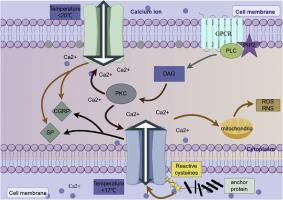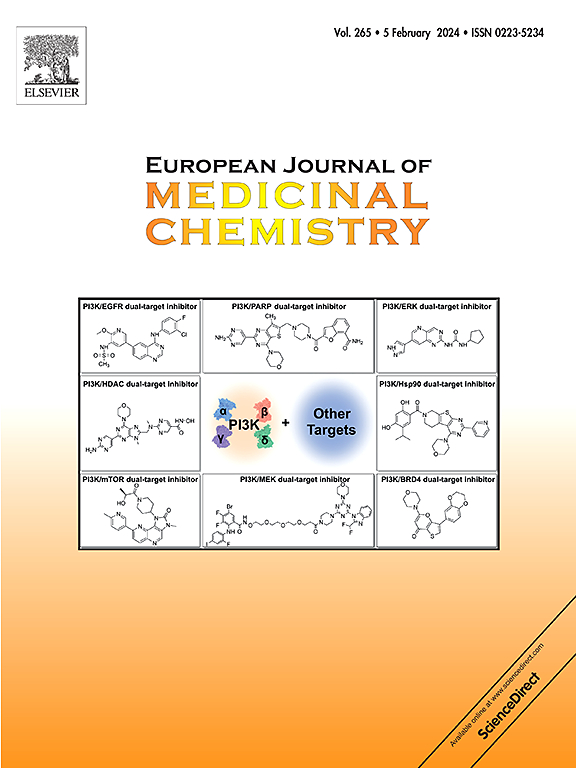TRPM8 and TRPA1 Ideal Targets for Treating Cold-Induced Pain
IF 6
2区 医学
Q1 CHEMISTRY, MEDICINAL
引用次数: 0
Abstract
TRP channels are essential for detecting variations in external temperature and are ubiquitously expressed in both the peripheral and central nervous systems as integral channel proteins. They primarily mediate a range of sensory responses, including thermal sensations, nociception, mechanosensation, vision, and gustation, thus playing a critical role in regulating various physiological functions. In colder climates, individuals often experience pain associated with low temperatures, leading to significant discomfort. Within the TRP channel family, TRPM8 and TRPA1 ion channels serve as the primary sensors for cold temperature fluctuations and are integral to both cold nociception and neuropathic pain pathways. Recent advancements in the biosynthesis of inhibitors targeting TRPM8 and TRPA1 have prompted the need for a comprehensive review of their structural characteristics, biological activities, biosynthetic pathways, and chemical synthesis. This paper aims to delineate the distinct roles of TRPM8 and TRPA1 in pain perception, elucidate their respective protein structures, and compile various combinations of TRPM8 and TRPA1 antagonists and agonists. The discussion encompasses their chemical structures, structure-activity relationships (SARs), biological activities, selectivity, and therapeutic potential, with a particular focus on the conformational relationships between antagonists and the channels. This review seeks to provide in-depth insights into pharmacological strategies for managing pain associated with TRPM8 and TRPA1 activation and will pave the way for future investigations into pharmacotherapeutic approaches for alleviating cold-induced pain.

TRPM8和TRPA1是治疗冷引起的疼痛的理想靶点
TRP 通道是检测外部温度变化的基本通道,在外周神经系统和中枢神经系统中都以完整通道蛋白的形式广泛表达。它们主要介导一系列感觉反应,包括热感觉、痛觉、机械感觉、视觉和味觉,因此在调节各种生理功能方面发挥着至关重要的作用。在寒冷的气候条件下,人们经常会因低温而感到疼痛,从而导致严重不适。在 TRP 通道家族中,TRPM8 和 TRPA1 离子通道是冷温度波动的主要传感器,是冷痛觉和神经性疼痛通路不可或缺的组成部分。最近在针对 TRPM8 和 TRPA1 的抑制剂的生物合成方面取得的进展促使人们需要对其结构特征、生物活性、生物合成途径和化学合成进行全面回顾。本文旨在描述 TRPM8 和 TRPA1 在痛觉中的不同作用,阐明它们各自的蛋白质结构,并汇编 TRPM8 和 TRPA1 拮抗剂和激动剂的各种组合。讨论内容包括它们的化学结构、结构-活性关系(SAR)、生物活性、选择性和治疗潜力,尤其侧重于拮抗剂与通道之间的构象关系。本综述旨在深入探讨治疗与 TRPM8 和 TRPA1 激活相关的疼痛的药理学策略,并为今后研究缓解寒冷引起的疼痛的药物治疗方法铺平道路。
本文章由计算机程序翻译,如有差异,请以英文原文为准。
求助全文
约1分钟内获得全文
求助全文
来源期刊
CiteScore
11.70
自引率
9.00%
发文量
863
审稿时长
29 days
期刊介绍:
The European Journal of Medicinal Chemistry is a global journal that publishes studies on all aspects of medicinal chemistry. It provides a medium for publication of original papers and also welcomes critical review papers.
A typical paper would report on the organic synthesis, characterization and pharmacological evaluation of compounds. Other topics of interest are drug design, QSAR, molecular modeling, drug-receptor interactions, molecular aspects of drug metabolism, prodrug synthesis and drug targeting. The journal expects manuscripts to present the rational for a study, provide insight into the design of compounds or understanding of mechanism, or clarify the targets.

 求助内容:
求助内容: 应助结果提醒方式:
应助结果提醒方式:


